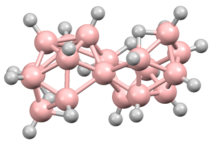Octadecaborane
Appearance
 | |
 | |
| Names | |
|---|---|
| Other names
octadecaborane; octadecaboron doicosahydride; octodecaborane; n-Octadecaborane; i-Octadecaborane
| |
| Identifiers | |
3D model (
JSmol ) |
|
ECHA InfoCard
|
100.224.871 |
| EC Number |
|
CompTox Dashboard (EPA)
|
|
| |
SMILES
| |
| Properties | |
| B18H22 | |
| Molar mass | 216.77 g/mol |
| Appearance | White to off white powder |
| Density | 1.012 g/cm3 |
| Melting point | 180 and 129 °C (356 and 264 °F; 453 and 402 K) n-B18H22 and i-B18H22 respectively |
Except where otherwise noted, data are given for materials in their standard state (at 25 °C [77 °F], 100 kPa).
| |
Octadecaborane is an
boron hydrides
. Although the compound has no practical applications, its structure is of theoretical and pedagogical interest.
Synthesis
It is formed by oxidative degradation of B20H182− or by
oxidative coupling
of B9H12−.
Structure
Two isomers are known of octadecaborane, providing the first example of isomers in a boron-hydride cluster. The clusters are also of interest because the boron centers shared between the two subunits have an unusually high number of B-B interactions. The isomers consists of two B9H11
polyhedral subunits, each having a decaborane-like form, joined at a B–B edge.[1][2] These two boron atoms are each coordinated to six others; this compound was the first one found to have such a high number of borons coordinated around a single boron center.[3] There are two different geometric isomers of this compound, differing in the orientation of the two edge-fused polyhedra to each other.[1][2] This compound was the first borane found to have multiple isomeric forms.[4] Among the geometric isomers, one with chirality was the first borane to be resolved into its separate enantiomers, and was only the second chiral borane known at that time.[5]
